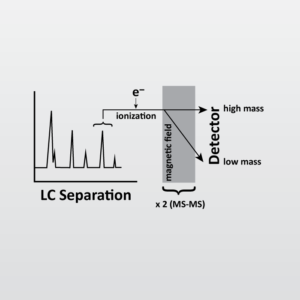Liquid Chromatography Tandem Mass Spectrometry (LC-MS-MS)
Home » Liquid Chromatography Tandem Mass Spectrometry LC-MS-MS
Liquid Chromatography with tandem mass spectrometry (LC-MS-MS) is a powerful analytical technique that combines the separating power of liquid chromatography with the highly sensitive and selective mass analysis capability of triple quadrupole mass spectrometry.
A sample solution containing analtyes of interest are pumped through a stationary phase (LC column) by a mobile phase flowing through at high pressure. Chemical interaction between the components of the sample, the stationary phase and the mobile phase affects different migration rates through the LC column affecting a separation. The wide variety of stationary phase and mobile phase combinations allow for customizing a separation to suit many complex solutions.
After elution from the LC column, the effluent is directed to the mass spectrometer. The mass spectrometer for an LC/MS/MS system has an ionization source where the LC column effluent is nebulized, desolvated and ionized creating charged particles.

These charged particles then migrate under high vacuum through a series of mass analyzers (quadrupole) by applying electromagnetic fields. A specific mass/charge precursor ion (or parent ion) is targeted to pass through the first quadrupole, excluding all other mass/charge ratio particles. In the collision cell, the selected mass/charge ions are then fragmented into product ions (or daughter ions) by collision with an inert gas. The third quadrupole is used to target specific product ion fragments. The resulting isolated product ions are then quantified with an electron multiplier. This transition of ions from the precursor to product ion (also referred to as MS2) is highly specific to the structure of the compound of interest and therefore provides a high degree of selectivity.
The strength of this technique lies in the separation power of LC for a wide range of compounds combined with the capability of the MS to quantify compounds with a high degree of sensitivity and selectivity based on the unique mass/charge (m/z) transitions of each compound of interest.
EAG has unparalleled experience with the operation and application of this powerful technique to quantify a wide variety of compounds in a wide variety of matrices. EAG employs the latest instrumentation with industry leading standards for sensitivity and accuracy.
Ideal Uses
- Trace analysis in:
- Environmental samples (i.e. soil, water, sediment)
- Pharmaceutical analyses (i.e. active ingredient or impurity analyses)
- Biological samples (i.e. crops, livestock tissues, milk, eggs, blood, urine)
- Structure confirmation analyses
- Direct injection MS/MS (no LC separation)
- Analysis of compounds lacking UV chromophores
- Updating existing methodology for higher specificity or sensitivity
- Medical device chemical characterization via ISO 10993:18
Strengths
- LC affords great range of chromatographic separation options
- High specificity of detector. No need for confirmatory detection method
- High sensitivity. Can detect some compounds below 1 part per trillion
- Excellent reproducibility when stable labeled internal standards are available
Limitations
- Matrix co-extractants can suppression or enhance ionization potential. May need to employ matrix matched calibrants for quantitation.
- Without the use of stable-labeled internal standards, the reproducibility is often not as good as LC-UV or other LC detectors.
- Limited use for large molecules (> 4,000 m/z)
LC-MS-MS Technical Specifications
- Mass analysis of compounds with < ~ 4,000 m/z
- Unit mass resolution
- Can be used with reverse phase LC and normal phase LC
Would you like to learn more about LC-MS-MS?
Contact us today for your Liquid Chromatography Tandem Mass Spectrometry needs. Please complete the form below to have an EAG expert contact you.